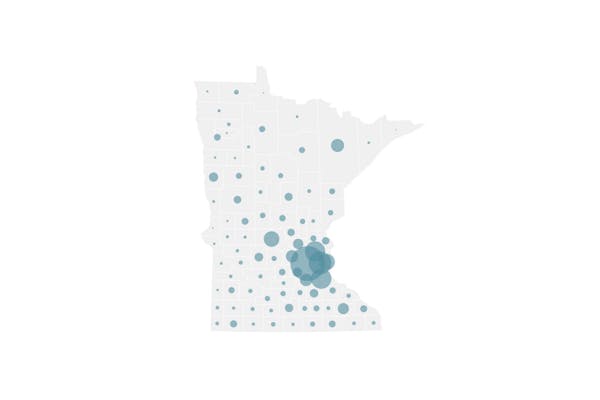Minnesota's COVID-19 hospitalization numbers rose back above 300 for the first time in September, reflecting concerns that rising spread in late August of a novel coronavirus would lead to more serious illnesses.
The Minnesota Department of Health on Wednesday reported that 303 people were hospitalized with COVID-19, and that 148 needed intensive care due to breathing problems or other complications from the infectious disease. The intensive care number is at its highest since Aug. 22.
The state on Wednesday also reported six COVID-19 deaths and 690 lab-confirmed infections, raising Minnesota's totals in the pandemic to 1,985 deaths and 92,100 infections confirmed through diagnostic testing. Five of the deaths involved people 70 or older, and the sixth involved a Hennepin County resident in the 60 to 64 age range.
Three of the COVID-19 deaths reported Wednesday involved residents of long-term care and assisted-living facilities. While such congregate care residents make up 72% of all COVID-19 deaths in Minnesota, that disparity has evened out. Nearly half of all COVID-19 deaths over the past month have involved people living in private residences.
Health officials continue to monitor COVID-19 infection data for signs of a surge following Labor Day weekend activities and the resumption of K-12 and college classes this month. While infections may have occurred this summer more among younger adults and teenagers at lower risks of severe COVID-19, they can then spread the virus to older adults at higher risks.
More than nine in 10 COVID-19 deaths have involved people 70 or older, or younger adults with chronic health problems such as diabetes or diseases of the kidneys, lungs or heart.
One statistical measure of the COVID-19 pandemic in Minnesota continues to show a favorable trend on the state's COVID-19 dashboard. The positivity rate of diagnostic testing remains below 5%, which is a threshold for the prevalence of the virus across the state. However, the latest state data indicates that 35% of confirmed infections are coming from unknown community sources, meaning the virus is spreading beyond the state's ability to track and contain it.
Hospitalizations for COVID-19 are well below the 606 reported at the peak of the pandemic on May 28. Gov. Tim Walz last week said he is confident in the capacity of Minnesota's hospitals to see out the pandemic, even in the event of a "twindemic" of COVID-19 and influenza this winter.
An ongoing state review of hospital outcomes showed that the average length of stay has shortened amid improved oxygen management of COVID-19 patients with breathing problems and increased use of the steroid dexamethasone and antiviral remdesivir for treatment.
The review of the first 4,945 hospitalized patients showed that 29% required intensive care and 17% were placed on ventilators to maintain adequate oxygen intake during their illnesses. The latest data showed that 11% of hospitalized patients died. The state had reported a 15% death rate in mid-May among the first 1,104 hospitalized patients.
Jeremy Olson • 612-673-7744
Carolyn Parnell, 'trailblazer' who served as Minnesota's first IT commissioner, dies

